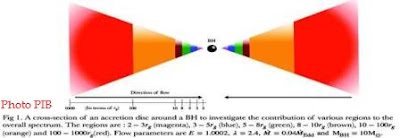
Scientists have found the formula that can assess the spectrum emitted from the accretion discs around black holes. Spectra of accretion discs can help estimate the mass of the black hole.
Government to set up Neutrino Observatory in the country: Know Complete List Here
Accretion flow around BH is composed of ionised plasma, which is a soup of bare electrons and protons. Since electrons are more prone to radiative losses than the protons, it is expected that around a BH, electrons and protons would settle down into two separate temperature distributions. Therefore, the two-temperature equations are generally solved to obtain the emitted spectrum from the electron temperature distribution. This is known as two-temperature modeling of accretion flows.
Atal Tunnel-The longest Highway Tunnel in the World: Things you Need to Know
Scientists from Aryabhatta Research Institute of Observational Sciences (ARIES), an autonomous institute under the Department of Science and Technology (DST), Govt. of India, investigated the nature of these two-temperature flows.
The research led by Shilpa Sarkar and Indranil Chattopadhyay from ARIES along with Philippe Laurent from IRFU / Service d’ Astrophysique and Laboratoire Astroparticule et Cosmologie, which has been recently accepted for publication in the journal Astronomy & Astrophysics (A&A), found that the number of unknown variables in the two-temperature regime exceeds the number of equations present. Hence, we get multiple solutions for the same set of constants of motion, like total energy or mass-inflow rate.
Exhaled Breath may Soon Help in Detecting Bacteria that Infect the Stomach: Research
Looking for a unique solution, scientists have developed a new formula called the Sarkar & Chattopadhyay form of entropy formula that can only be applied near the horizon where gravity overpowers any other interactions like energy exchange terms between ions and electrons. This novel approach helped in selecting a unique solution out of the multiple solutions of accretion disc spectrum emission around a BH. Entropy is the measure of randomness in any system. In two temperature solutions, the formula for measure of entropy does not exist. This new formula allows to measure the entropy of the flow close to the black hole horizon. According to the second law of thermodynamics, nature selects or prefers those processes which maximize entropy. ARIES team showed that there exists one solution for which the entropy is maximum and thereby broke the multiplicity of solutions.
Is Your Tea safe in Paper Cup: IIT Scientists Proves Existence of Micro-plastic Pollution in it
Using this formula, they found that with the increase of the mass supply to the central BH, the accretion disc becomes brighter and more high energy photons are emitted. With the increase of mass of the BH, luminosity increases, and the bandwidth of the emitted spectrum, both in the high energy and low energy range, increases, but the spectral shape does not change. In other words, matter around a massive BH will produce a lot of photons in the low energy and high energy band, but around a smaller BH, it will emit predominantly in the X-rays.
Self-Discipline: The Power to Set Boundaries of Life and Lead the mind for Ultimate goal
According to the ARIES team, this is the first time any approach of removing degeneracy from two-temperature theory has been proposed. It is necessary to obtain a correct solution, and hence a correct spectrum for any accretion flow around BH as any arbitrary choice of solution would give us a wrong picture of the system. The results could contribute in the understanding of physical processes around extreme objects like BHs. (Source PIB)

Post a Comment